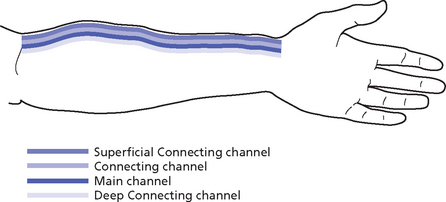Chapter 52 The Connecting channels are called Luo Mai: Luo implies the meaning of ‘network’. (The Main channels are called Jing Mai, and Jing implies the meaning of ‘line’, ‘route’, ‘way’.) Chapter 17 of the ‘Spiritual Axis’ confirms that the Connecting channels are ‘horizontal’ or ‘crosswise’: ‘The Main channels are in the Interior, their branches are horizontal [or crosswise] forming the Luo channels’.1 The Connecting channels are more superficial than the Main channels and they run in all directions, horizontally rather than vertically. In particular, they fill the space between skin and muscles (i.e. the Cou Li space). The components of each channel system correspond to different energetic layers pertaining to that channel. For example, if we take the Lung channel, the most superficial part of it is the skin overlying the channel pathway; below that, there is the space between skin and muscles or Li space, that is, the space between the skin and muscles where the Superficial Connecting channels course; below that, the Connecting channel proper fills the space between the muscles and sinews: below that, there is the Lung Main channel and below that, the Lung Deep Connecting channel (Fig. 52.1). It is important to visualize the Connecting channels not as lines but as spaces filled by channels. Chapter 17 of the ‘Spiritual Axis’ says: ‘The Main channels are in the Interior, their branches are horizontal [or crosswise] forming the Luo channels: branching out from these are the Minute Luo’.2 Chapter 10 of the same book says: ‘The more superficial branches of the channels which can be seen are the Luo channels’.3 Chapter 58 of the ‘Simple Questions’ states: ‘The Minute Luo [Sun Luo] communicate with the 365 points’.4 The Connecting channels cannot penetrate the big joints of the body (as do the Main channels) and they are therefore restricted to the spaces in between the deep pathway of the Main channels and the surface of the body. The Connecting channels also fill the spaces and ‘cavities’ of the body, which are all part of the Triple Burner. This means that most of the stagnation in the body actually occurs in the Connecting channels because they are ‘constricted’ in these spaces (as they cannot course through the large joints) and because they form like a net which easily ‘catches’ pathogenic factors or in which Qi or Blood, or both, become stagnant. Chapter 10 of the ‘Spiritual Axis’ says: The Luo channels cannot course through the large joints; in order to [enter and] exit they must move by alternate routes. They then enter and come together again under the skin and therefore they can be seen from the outside. To needle the Luo channel one must needle above the accumulation where Blood is concentrated. Even if there is no blood accumulation, one must prick to cause bleeding quickly to drain the pathogenic factors out: if this is not done, Bi syndrome may develop.5 Palpation of the limbs involves essentially palpation of the Connecting channels and especially the Superficial Connecting channels and the Connecting channels proper. Generally speaking, the more distal the point, the more it reflects the state of the Connecting channels, whereas the more proximal the point, the more it reflects the state of the Main channels. For example, palpation of the forearm from LU-10 to LU-3 and slightly beyond reflects the state of the Lung Connecting channel portion; palpation in the area of LU-2 and LU-1 reflects more the state of the Lung Main channel (and the organ itself). The Muscle channels are called Jing Jin, which could be translated as ‘channel-like muscles’ or ‘muscles of the channels’. They are discussed in Chapter 13 of the ‘Spiritual Axis’. Identifying the affected channel through palpation is absolutely essential for the choice of both distal and local points. For example, in shoulder problems, one must clearly identify the channel involved, which may be Small Intestine, Triple Burner, Large Intestine or Lung channel. If the pulsation in the area of LI-5 Yangxi is superficial and large, this indicates conditions such as facial paralysis, tooth abscess or external Wind-Heat; if it is deep it may indicate an intestinal pathology such as abdominal pain, constipation or diarrhoea. If it is rapid this denotes a Heat condition of the Large Intestine and if it is slow a Cold condition. If the pulsation feels empty this denotes an Empty condition of the Large Intestine, and if it feels full a Full condition with stagnation and abdominal pain.
 PALPATION OF CHANNELS
PALPATION OF CHANNELS
CONNECTING CHANNELS
Palpation
MUSCLE CHANNELS
PALPATION OF THE CHANNELS IN PAINFUL OBSTRUCTION SYNDROME (BI)
PALPATION OF CHANNELS
Lung channel
Large Intestine channel
Palpation of blood vessel
PALPATION OF CHANNELS




